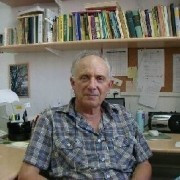For a full list
- Galil and D. Eisikowitch. On the pollination ecology of Ficus sycomorus in East Africa. Ecology, vol.49, 1968 (pp.259-269)
- Galil, J. and D. Eisikowitch. Flowering cycles and fruit types of ficus sycomorus in Israel. New Phytol. vol.67, 1968 (pp.754-758)
- Galil, J. and D. Eisikowitch. On the pollination ecology of Ficus religiosa in Israel. Phytomorphology vol.18,1968 (pp.356-363).
- Galil, J. and D. Eisikowitch. Note on pollen transport, pollination and protection of ovaries in Ficus sycomorus. New Phytol, vol. 68 1968(pp.1243-1245).
- Galil, J. and D. Eisikowitch. Further studies on the pollination ecology of Ficus sycomorus L. Tidj. Ent. vol.112, 1969 (pp. 1-13)
- Galil, J. and D. Eisikowitch. Studies in mutualistic Symbiosis between syconia and sycophylous wasps in monoecious fig. New Phytol.vol. 70, 1970 (pp.773-787).
- Eisikowitch, D. and J. Galil. Effect of wind on the pollination of Pancratium maritmum L. by hawkmoths. J. Anim. Ecol. vol.40, 1971(pp. 673-678)
- Eisikowitch, D. Mode of pollination as a consequence of ecological factors. Taxonomy and Ecology. Vol. 5, Academic Press, London 1973.
- J. Galil, W. Ramirez and D. Eisikowitch. Pollination of Ficus costaricana and F. hemsleyana by Blastophaga esterae and and B. tonduzi Costa Rica (Hymenophera: Chalcidoildea, Agaonides). Tijd. Voor. Entom. vol.116, 1973(pp. 75-186)
- Galil. J. and D. Eisikowitch. Further studies on pollination ecology in Ficus sycomorus. Magr. New Phytol. vol.73, 1974 (pp.515-528)
- Eisikowitch, D. and S.R.J. Woodell. The effect of water on pollen germination in two species of Primula. Evolution, vol. 28, 1975 (pp .692-694).
- Eisikowitch, D. and S.R.J. Woodell. Some aspects of pollination ecology of Armeria maritim
a. New Phytol. vol. 74, 1975 (pp. 307-322)
- Eisikowitch, D. Insect visiting of two subspecies of Nigella arvensis under adverse conditions. In The Pollination of flowers by Insects. Academic Press, London, 1978, (pp.125-132 ).
- Eisikowitch D. and Y. Masad. Nectar-yielding plants during the dearth period in Israel. Bee World, vol.61, 1980 (pp. 11-18)
- Eisikowitch, D. The role of dark flowers in the pollination of certain Umbelliferae. J. Nat. His. vol.14, 1980 (pp. 737-742)
- Eisikowitch, D. Horned poppy, Glaucium flavum in Israel: Notes in its pollination and distribution. Isr. J. Bot., vol. 28, 1980 (pp. 87-97)
- Eisikowitch, D. Some aspects of pollination of oil seed rape (Brassica napus L.) J. of Agric. Sci. Camb. vol.96, 1981 (pp. 321-326)
- Reves, Y. and D. Eisikowitch. Acclimatization of Eucalyptus under semi-arid conditions. Int. J. Biometer. vol. 25, 1981, (pp. 21-28)
- Corbet, S.A., J. Beament and D. Eisikowitch. Are electrostatic forces involved in pollen transfer? Plant Cell and Environment, vol.5, 1982, (pp. 125-129)
- Eisikowitch, D. and N. Nahari. The discrimination of Malvaviscus arboreus flowers by sunbirds Nectarinia osea. Acta. Bot. Neer, vol. 1, 1982, pp. 55-58)
- Eisikowitch, D. and Y. Masad. Preferences of honey bees for different ornamental nectar yielding plants during the dearth period in Israel. Bee World, vol. 63, 1982 (pp. 77-82)
- Eisikowitch, D. and Y. Reves. Eucalyptus torquata, the coral flowered gum. An attractive plant for honeybees in Israel. Am. Bee J. vol.123, 1983 (pp. 576-577)
- Eisikowitch, D. and G.M. Loper. Some aspects of flower biology and bee activity on hybrid cotton in Arizona, U.S.A. J. of Apic Res. vol.23, 1984 (pp. 243-248)
- Eisikowitch, D. and A. Lupo. A simple method of controlling bee flight during daytime. Am. Bee J. vol.124, 1984 (pp. 733-735)
- Eisikowitch, D. Morphological aspects on the pollinations of Calotropis procera (Asclepiadaceae) in Israel. Pl. Sy. Evol, vol.152, 1986(pp. 185-194)
- Eisikowitch, D. The search for nectariferous plants in marginal agricultural regions in Israel. Am. Bee J. vol.126, 1986 (pp. 181-183)
- Goldstein, H., D. Eisikowitch and Y. Yom-Tov. Infanticides in the Palestine Sunbirds Nectarinia Osea. The Condor, vol. 88, 1986 (pp. 528-529)
- Eisikowitch, D.,Y. Ivri and A. Dafni. Reward partitioning in Capparis spp. along an ecological gradient. Oecologia, vol. 71, 1986 (pp. 47-50)
- Eisikowitch, D. and R. Rotem. Flower orientation and colour change in Quisqualis indica and its possible role on pollinator partitioning. Bot. Gaz. vol.148, 1987 (pp. 175-179)
- Eisikowitch, D. and Z. Lazar. Flower change in Oenothera drummondii as a response to pollinators visits. J. Linn. Soc. vol. 95, 1987 (pp. 101-111)
- Goldstein, H., N.A.M. Verbeek, D. Eisikowitch and Y. Yom-Tov. Sunbirds prefer to feed in sun. Ardea. vol. 75, 1987 (pp. 293-295)
- Dafni, A., D. Eisikowitch and Y. Ivri. Nectar flow and Pollinator's efficiency in two co-occurring species of Capparis (Capparaceae). Pl. Sy. Evol. vol.157, 1987 (pp. 181-186)
- Eisikowitch D., P. G. Kevan, S. Fowle and K. Thomas. The significance of pollen longevity in Asclepias syriaca L. under natural condition. Pollen et Spores, vol.29, 1987(pp.121-128).
- Eisikowitch, D. and A. Dafni. The use and abuse of introducing honey plants. Bee World. vol.69,1988 (pp. 12-14).
- Orr, N. and D. Eisikowitch. Interactions between melons and honeybees under extreme desert conditions in Israel. Apidologie, vol.19, 1988 (pp. 85-96).
- Kevan, P.G., D. Eisikowitch, Z. Fowle and K. Thomas. Yeast contaminated nectar and its effect on bee visits and movements. J. Apic. Res. vol. 27, 1988(pp. 26-29)
- Eisikowitch, D. Flowers-insects interrelations- A case of unusual predation. Evolutionary Theory vol. 8, 1988 (pp.151-154).
- Kevan, P.G., D. Eisikowitch and B. Rathwell. The role of nectar in the germination of pollen in Asclepias syriaca L. Bot. Gaz. vol.150, 1989(pp. 266-270).
- Beker, R., A. Dafni, D. Eisikowitch and U. Ravid. Volatiles of two chemotypes of Majorana syriaca L.(Labiatae) as olfactory cues for the honeybee. Oecologia, vol. 79, 1989 (pp. 446- 451).
- Eisikowitch, D., P.G. Kevan, and M.A. Lachance. The nectar-inhabiting yeasts and their effect on pollen germination in common milkweed, Asclepias syriaca L. Isr. J. Bot. vol.39, 1990 (pp.217-225).
- Lupo, A. and D. Eisikowitch. Eucalyptus erythrocoris: a source of nectar and pollen for honey bees in Israel. Apidologie, vol. 21, 1990(pp. 25-33).
- Kevan, P.G. and D. Eisikowitch. The effects of insect pollination on Canola (Brassica napus L. cv. O.A.C. Triton) seed germination. Euphytica, vol.45, 1990 (pp. 39-41).
- Kevan, P.G., D. Eisikowitch, J. D. Ambrose and J.P. Kemp. Cryptic dioecy and insect pollination in Rosa setigera Michy. (Rosaceae), A rareplants of Carolinian Canada. J. Linn. Soc. vol.40, 1990 (pp.229-243).
- Eisikowitch, D., M.A. Lachance, P.G. Kevan, S. Willis and D.L. Collins-Thompson. The effect of the natural assemblage of microorganisms and selected strains of the yeast Metschnikowia reukaufii in controlling the germination of pollen of the common milkweed Asclepias syriaca. Can. J. Bot. vol.68, 1990 (pp. 1163-1165).
- Ish-Am, G. and D. Eisikowitch. Possible routes of avocado tree pollination by honeybees. On seed number and productivity. Acta Hort. vol. 288, 1990 (pp. 275-277).
- De Grandi-Hoffman, G., R. Thorp, G. Loper and D. Eisikowitch. The influence of nectar and pollen availability on blossom density on the attractiveness of almond cultivars to honeybees. Acta Hort. vol. 288, 1991 (pp.299-302).
- Lupo, A., D. Eisikowitch and P. Brosh. Pollination in the "Murcott" cultivar of Citrus (Rutaceae), the influence on seed number and productivity. Acta Hort. vol. 288, 1991(pp. 275-277).
- Ish-Am, G. and Eisikowitch, D., New insight into avocado flowering in relation to its pollination. California Avocado Society Yearbook, vol. 75, 1991. pp.125-137.
- De Grandi-Hoffman, G., R. Thorp, G. Loper and D. Eisikowitch. Identification of Cross-pollinating honeybees on Almonds. J. App. Ecol., vol. 29, 1992 (pp.238-246).
- Ish-Am, G. and D. Eisikowitch. The behaviour of honeybees (Apis mellifera) visiting Avocado (Persea americana) flowers and their contribution to its pollination J. Apic. Res. vol.32, 1993 (pp. 175-186).
- Dagan, R. and D. Eisikowitch. Calotropis gigantea in Israel: A new arrival or new discovery. Isr. J. Pl. Sci . vol. 42, 1994 (pp. 167-168).
- Gan-Mor, S., Y. Schwarz, A. Bechar, D. Eisikowitch and G. Manor. Relevance of electrostatic forces in natural and artificial pollination. Can. Agr. Eng. vol.37, 1995 (pp.189-194).
- Dag A. and D. Eisikowitch The influence of hive location on honeybee foraging activity and fruit set in melons grown in plastic greenhouses. Apidologie, vol. 26, 1995 (pp.511-519).
- Vaknin, Y., Y. Yom-Tov and D. Eisikowitch. Flowering seasonality and flower characteristics of Loranthus Acaciae Zucc. (Lorantaceae): Implication for advertisement and bird pollination. Sex. Pl. Rep. vol. 9, 1996 (pp.279-285).
- Eisikowitch, D. and G. Ish-Am The ecology of crop pollination in the Mediterranean region. Bocconea, vol. 5, 1996 (pp.183-191).
- De Grandi-Hoffman, G., R.Thorp,G. Loper and D. Eisikowitch. Describing the progression of almond bloom using accumulated heat units. J. Appl. Ecol. vol. 33, 1996 (pp. 812-818).
- Bechar, A., S. Gan-Mor, Y. Vaknin, I, Shmulevich, B. Ronen and D. Eisikowitch. An image analysis technique for accurate counting of pollen on stigmas. New Phytol. vol. 1998 (pp. 639-643).
- Ish-Am G. and D. Eisikowitch. Low attractiveness of avocado (Persea americana L.) flowers to honeybees (Apis mellifera L.) limits fruit set in Israel. J. Hort. Sc. Biotech. vol. 73 ,1998 (pp 192-195.).
- Ish-Am, G. and D. Eisikowitch. Mobility of honey bees (Apidae, Apis mellifera L.) during foraging in Avocado orchards. Apidologie vol. 29, 1998 (pp. 209-219).
- Vaknin, Y., S .Gan-Mor, A. Bechar, B. Ronen and D. Eisikowitch. Effect of desiccation and dilution of almond pollen. J. Hort. Sc. Biotech. vol. 74, 1999 (pp 321-327).
- Eisikowitch, D. and H. Wetzstein. Enhance of pollen germination by promotive factors in compatible pollen. Isr. J. Pl. Sc. vol. 49,1999 (pp165-168).
- Dag, A. and D. Eisikowitch. Ventilation of greenhouses increases honey bee foraging activity on Melon, Cucumis melo. J. Apic. Res. Vol. 38 1999 (169-175).
- Vaknin, Y., S. Gan-More, A. Bechar, B.Ronen and D. Eisikowitch. Improving pollination of almonds (Amygdalus communis L.; Rosaceae) using electrostatic techniques. Journal of Horticultural Science and Biotechnology. 76, no. 2, 2001 pp. 208-212.
- Law, S.E., Wetzstein, H.Y., Banerjee, S. and Eisikowitch, D., Electrostatic application of pollen sprays: effects of charging field intensity and aerodynamic shear upon deposition and germinability. IEEE Transactions on Industry Applications, 36(4) 2000, pp. 998-1009.
65. Dag, A. and D. Eisikowitch. The effect of carbon dioxide on nectar production in melons under greenhouse conditions. J. Apic. Res. vol. 40, 2000 (pp. 88-89).
66. Goldway, M., Schneider, D., Yehuda, H., Matityahu, A., Eisikowitch, D. and R.A. Stern. The effect of apple S-allele compatibility on fruit set levels in non-optimal fertilization conditions. In VIII International Symposium on Pollination-Pollination:
Integrator of Crops and Native Plant Systems 561, 2000, (pp. 231-234).
67.Vaknin Y., and D. Eisikowitch. Effect of short-term storage on germinability of Pistachio pollen. Plant Breeding vol.119, 2000 (pp. 347-350).
69. Vaknin, Y., Gan-Mor, S., Bechar, A., Ronen, B. and. Eisikowitch. The role of electrostatic forces in pollination. Plant Systematic and Evolution 2000 VOL.pp.133-142.
70. Eisikowitch, D. and Dag, A., 2001. Are wild flowers and cultivated plants: friends or foes. Proc. 37th Apimondia Int. Apic. Cong. Durban, South Africa
71. Schneider, D., Stern, R., Eisikowitch, D. and , M. Goldway. Analysis of S-alleles by PCR for determination of compatibility in the ‘Red Delicious’ apple orchard. J.f Hort. Sc. Biotech. 76(5), 2001. pp.596-600.
72. Stern, R., Eisikowitch, D. and, A. Dag. Sequential introduction of honeybee colonies and doubling their density increases cross-pollination, fruit-set and yield in ‘Red Delicious’ apple. The J. Hort. Biotech. 2001.76(1), pp.17-23.
73. Goldway, M., Schneider, D., Yehuda, H., Matityahu, A., Eisikowitch, D. and R.A. Stern. The effect of apple S-allele compatibility on fruit set levels in non-optimal fertilization conditions. VIII International Symposium on Pollination-Pollination:
Integrator of Crops and Native Plant Systems 561, 2000, pp. 231-234.
74. Vaknin, Y., S. Gan‐mor, A. Bechar, B. Ronen and D. Eisikowitch. Are flowers morphologically adapted to take advantage of electrostatic forces in pollination?. New Phytol. 152(2), 2001, pp.301-306.
75. Vaknin, Y., S. Gan-Mor, A. Bechar, B. Ronen, and D. Eisikowitch. Improving pollination of almond (Amygdalus communis L., Rosaceae) using electrostatic techniques. J. Hortic. Sci. Biotechnol. 76(2), 2001, pp. 208-212.
76. Schneider, D., Stern, R.A., Eisikowitch, D. and Goldway, M., 2002. The relationship between floral structure and honeybee pollination efficiency in ‘Jonathan’and ‘Topred’apple cultivars. J. Hortic. Sci. Biotechnol. 77(1), pp.48-51.
77. Schneider, D., Stern, R.A., Eisikowitch, D. and M. Goldway. The relationship between floral structure and honeybee pollination eficiency in ‘Jonathan’and ‘Topred’apple cultivars. The J. Hortic. Sci. Biotechnol. 77(1), 2002, pp.48-51.
78. Gan–Mor, S., Bechar, A., Ronen, B., Eisikowitch, D. and Y. Vaknin. Improving electrostatic pollination inside tree canopy via simulations and field tests. Transactions of the ASAE, 46(3), 2003, p.839.
79. Gan–Mor, S., Bechar, A., Ronen, B., Eisikowitch, D. and Y. Vaknin. Electrostatic pollen applicator development and tests for almond, kiwi, date, and pistachio-an overview. Appl. Eng. Agric. 19(2), 2003, p.119.
80. London-Shafir, I., Shafir, S. and D. Eisikowitch. Amygdalin in almond nectar and pollen–facts and possible roles. Pl. Syst. Evol. 238(1), 2003, pp.87-95.
81. Samra, S., Samocha, Y., Eisikowitch, D. and Y. Vaknin. Can ants equal honeybees as effective pollinators of the energy crop Jatropha curcas L. under Mediterranean conditions?. GCB Bioenergy, 6(6), 2014, pp.756-767.
82. Sapir, G., Stern, R., Eisikowitch, D. and M. Goldway. Cloning of four new Japanese plum S-alleles and determination of the compatibility between cultivars by PCR analysis. J. Hortic. Sci. Biotechnol., 79(2), 2004, pp.223-227.
83. Schneider, D., Eisikowitch, D., Goldway, M. and R. Stern. A comparative study of the superior fertility of ‘Smoothee Golden Delicious’ apple. J. Hortic. Sci. Biotechnol. 79(4), 2004, pp.596-601.
84. Schwartz-Tzachor, R., Dafni, A., Potts, S.G. and D. Eisikowitch. An ancient pollinator of a contemporary plant (Cyclamen persicum): When pollination syndromes break down. Flora, 201(5), 2006.pp.370-373.
85. Kevan, P.G., Eisikowitch, D., Kinuthia, W., Martin, P., Mussen, E.C., Partap, U., Taylor, O.R., Thomas, V.G., Thorp, R.W., Vergara, C.H. and Winter, K.,. High High-qualityproducts are important to agriculture: why, and what needs to be done. J. Apic. Res. 46(1), 2007, pp. 59-64.
86.Schwartz-Tzachor, R., Eisikowitch, D. and A. Dafni. Flower characteristics and breeding system of two phenological ecotypes of Cyclamen persicum Mill. (Myrsinaceae) in Israel. Pl. Syst.Evol. 274(1), 2008, pp.127-134.
87. Gan-Mor, S., Ronen, B., Vaknin, Y., Glik, Y., Samocha, Y. and D. Eisikowitch. Further studies on electrostatic date pollination–from the laboratory bench to field unit performance test. Appl. Eng. Agric. 25(5), 2009. pp.643-646.
88. Vaknin, Y., Ghanim, M., Samra, S., Dvash, L., Hendelsman, E., Eisikowitch, D. and Y. Samocha, Predicting Jatropha curcas seed-oil content, oil composition and protein content using near-infrared spectroscopy—A quick and non-destructive method. Ind.
Crops Prod. 34(1), 2011, pp.1029-1034.
89. Samocha, Y., Eisikowitch, D. and Y. Vaknin. Pollen source effects on fruit and seed traits of Jatropha curcas L.—A renewable biodiesel feedstock. BioEnergy Res., 7(4), 2014. pp.1270-1279.
90. Samra, S., Samocha, Y., Eisikowitch, D. and Y. Vaknin. Can ants equal honeybees as effective pollinators of the energy crop Jatropha curcas L. under Mediterranean conditions?. GCB Bioenergy, 6(6), 2014, pp.756-767.
91. Eisikowitch, D. and M. Ghara. An overview on Ficus pollination with some notes on Ficus carica. Italus Hortus, 22 (3), 2015, pp.1-7.
93. Vaknin, Y., Samocha, Y. and Eisikowitch, D. Temporary incidence of polygamomonoecy in the biodiesel plant Jatropha curcas L. is associated with style polymorphism promoting automatic self-pollination. J. Poll. Ecol. 15, 2015, pp.38-43.
94.Vaknin, Y., Eisikowitch, D. and Mishal, A., Floral and pollen traits of Moringa oleifera Lam. and Moringa peregrina (Forssk.) fiori provide reproductive adaptations for arid conditions. Agronomy, 11(6), 2021, pp.1090.
95. Eisikowitch, D., Ghara, M., Peer, R. and M.A. Flaishman. Ficus–wasp mutualism with a Special emphasis on Ficus carica. Advances in Fig Research and Sustainable Production, vol. 5, 2022, p.59-69.
97. Mishal, A. and Eisikowitch, D., Pollen tube growth in Calotropis procera is controlled by environmental changes: does it have an impact on delayed fertilization?. J. Poll. Ecol. 31, 2022, pp.1-7.






